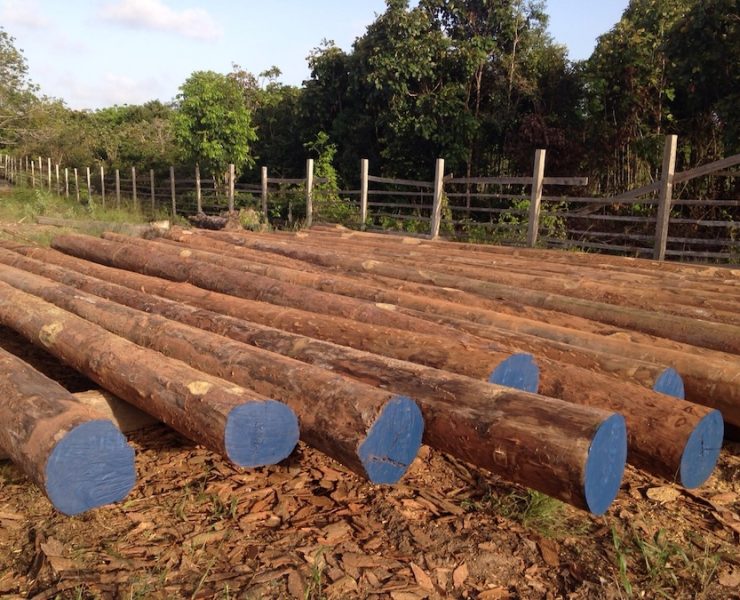Vinyl Sheet Piling with Gaskets Used in Combating Peatland Desiccation

View the complete article here.
By Dawid Jasinski
Peatlands, often overlooked in the global climate change discourse, play a key role as carbon storage, buffering greenhouse gas emissions. Their unique ability to sequester carbon makes them an invaluable component of natural ecosystems, significantly impacting the global carbon balance. Unfortunately, changing climate and human activities are increasingly leading to the drying of these areas, contributing to increased emissions of carbon dioxide (CO2) and methane (CH4), two major greenhouse gases driving global warming. Fortunately, in recent years, there has been more discussion about this issue, leading experts to feel the need to solve it, also through technologies and methods used in completely different industries. This article describes the application of more sustainable technologies, such as the use of vinyl sheet piling with gaskets in projects aimed at halting the drying of peatlands. These innovative solutions, though less traditional than natural materials like wood, offer a range of ecological, economic, and practical benefits.

Peatland desiccation is a complex phenomenon significantly impacting the global environment. Peatlands are ecosystems with a unique structure and function, playing a key role in the carbon cycle of our planet. They are among the largest natural carbon stores, containing vast amounts of carbon in their peat layers, absorbed over centuries. However, due to human activities and climate change, these sensitive ecosystems are degrading.
Factors such as intensified agriculture, urban expansion, excessive water resource usage, and large-scale peat exploitation contribute to lowering groundwater levels in peatlands. This leads to their desiccation, initiating the oxidation process of the stored carbon, resulting in significant releases of carbon dioxide and methane into the atmosphere. This forms a vicious cycle: climate change causes global temperature rises, accelerating peatland desiccation, which emits greenhouse gases, further speeding up climate warming.
Peatlands also play a vital role in regulating the water cycle. Their ability to store and gradually release water helps maintain hydrological stability in their regions. Thus, their drying can lead to serious changes in local water systems, impacting water availability for humans and agriculture.
According to research published in ‘Nature Climate Change’ [1], from 1850 to 2015, the loss of natural peatlands in temperate, boreal, and tropical zones has shifted these ecosystems from carbon sinks to emission sources. It is estimated that by 2100, emissions from drained peatlands could account for 12-41% of the global greenhouse gas emission budget needed to keep global warming below 1.5 to 2 °C. Fortunately, not all scientific data is so pessimistic, as research on Canadian peatlands shows that dried peatlands may emit an average of about 1.4 tons of carbon dioxide per hectare annually, about 50% lower than previously estimated. This lower amount results from not considering seasonality and climate variability in emission modeling. Nevertheless, we face a significant challenge in saving peatlands and possibly our climate from total collapse.

How are Peatlands Protected from Drying Out?
Protecting peatlands from desiccation involves a range of management and technical interventions. Crucial is restoring the natural groundwater level, often achieved by blocking drainage and melioration ditches. Biotechnical methods, like planting moisture-retaining plants, are also used. Legal protection and strict control over human activity in these areas are essential to prevent transformations leading to further drying. Additionally, education and raising public awareness about the significance of peatlands for the ecosystem and climate play a key role in their protection. Engineering solutions primarily include building various retention structures, like thresholds, small retention dams, and anti-drainage barriers in the ground. Traditionally, materials like wood, steel, and concrete have been used for these constructions, but their drawbacks, such as susceptibility to rot/corrosion, weight, and the need for periodic replacement, have led to the search for new solutions. One such technology is vinyl sheet piling with a gasket.

Vinyl sheet piling, an alternative to popular steel sheet piling, has been known in the market since the 1980s. They are made from environmentally durable PVC, often sourced from recycling. Their main advantage over steel sheet piling is their resistance to corrosion. Their extensive history, especially in civil and water engineering projects like flood prevention, marina construction, and small retaining structures, proves their viability for various reasons — not just cost and aesthetics, but also longevity [3] and ecology. As this article focuses on the ecological aspect, let’s concentrate on that. As proven in a Life Cycle Assessment (LCA) [4], their environmental impact is significantly lower compared to steel sheet piling.
This is due to several factors:
- from 1 ton of PVC, significantly more square feet of vinyl sheet piling can be produced than from 1 ton of steel.
- Since PVC is much lighter (about 5 times less dense than steel), it’s more ecological in transportation, allowing more square feet of vinyl sheet piling per transport unit.
- Vinyl sheet piling can be easily recycled, even after 50-100 years of installation. In contrast, steel sheet piling may be problematic due to corrosion, potentially rendering them unextractable after 50 years, necessitating natural degradation.
An important aspect is that vinyl sheet piling can be produced with an integrated soft PVC gasket. Is worth to emphasize that this gasket is thermaly-combined to the entire profile simultaneously at the time of its production, which ensures an integrated connection. This aspect means that a ready-to-use product arrives at the construction site, saving time and costs. In the case of steel sheet piles, such sealing takes place at site and involves applying sealant material that can be labor extensive, expensive and potential harmful to the environment. Solution of vinyl sheet pile with the integrated gasket ensures instant, complete water-tightness of the locks, i.e., the connections between individual profiles. Such a lock, along with the gasket, can withstand a pressure of 29psi in laboratory conditions.

Vinyl Sheet Piling in Peatland Protection Projects
The distinctive features of this technology have been recognized by environmental specialists, leading to its innovative use in creating impermeable anti-filtration barriers. These barriers prevent groundwater outflow from sensitive peatlands to lower-lying areas. The first project using this method was in a Polish nature reserve, part of the EU’s Natura 2000 program, aimed at preserving certain habitats and species considered valuable and endangered in Europe.
The vinyl sheet pilings, forming a wall, were driven about 10 feet deep and extend about 3 feet above ground level. The wall runs perpendicular to the water flow direction, effectively preventing excessive water outflow from the protected area, thus raising the groundwater level, preventing the peatland from drying out and emitting greenhouse gases.
Another project using vinyl sheet pilings with gaskets was part of a research project overseen by the University of Gothenburg. Here, special equipment measures greenhouse gas emissions from peatlands. Previously, the area was used for intensive peat extraction. Vinyl sheet pilings were installed to prevent excessive water outflow. Additionally, a water threshold was installed in a natural drainage ditch, set based on hydrological calculations.
In both projects, installing the vinyl sheet pilings was using an excavator bucket by simply pushing them into the ground. However, in normal soils, special guides are recommended. Both walls were also capped with a vinyl system coping for aesthetic enhancement.

Peatlands are crucial ecosystems for global climate balance, but climate change and human activity are causing their desiccation. This releases significant amounts of greenhouse gases, mainly CO2 and methane, accelerating the greenhouse effect and global warming. Facing this challenge, modern solutions like vinyl sheet pilings are being implemented in peatland protection projects. They effectively control the groundwater level, preventing peatland desiccation. Their durability, ecological benefits, and ease of installation make them a preferred solution in conserving peatlands and wetlands as natural carbon stores and combating climate change.
References:
Leifeld, J., Wüst-Galley, C., & Page, S. (2019). Intact and managed peatland soils as a source and sink of GHGs from 1850 to 2100. Nature Climate Change, 9, 945–947.
He, H., & Roulet, N. T. (2023). Improved estimates of carbon dioxide emissions from drained peatlands support a reduction in emission factor. Communications Earth & Environment, 4, Article 436.
Dutta, P.K., & Vaidya, U. (2003). A Study of the Long-Term Applications of Vinyl Sheet Piles. Cold Regions Research and Engineering Laboratory, U.S. Army Corps of Engineers.
Marcinkowski, A., & Gralewski, J. (2020). The comparison of the environmental impact of steel and vinyl sheet piling: life cycle assessment study. International Journal of Environmental Science and Technology.
The Pietrucha Group website. “Vinyl Sheet Piling Used to Enhance Retention Capabilities of a Nature Reserve.” https://www.pietrucha.pl/en/expertise/completed-projects/vinyl-sheet-piling-used-to-enhance-retention-capabilities-of-a-nature-reserve
Skogaryd Research Catchment [@SkogarydRC]. “Now the drainage ditches has been blocked and is already filled with water.” x.com, August 29, 2022, https://twitter.com/SkogarydRC/status/1564215664939859969
View the complete article here.
How does vinyl sheet piling help in combating peatland desiccation?
Vinyl sheet piling with gaskets creates impermeable barriers preventing groundwater outflow, raising groundwater levels, and reducing greenhouse gas emissions from drying peatlands. This method is effective, durable, and environmentally friendly compared to traditional materials like steel or wood.
What are the advantages of using vinyl sheet piling over traditional materials?
Vinyl sheet piling is resistant to corrosion, lighter, and easier to transport. It also integrates gaskets during production, ensuring water-tightness and simplifying installation. These features make it a more sustainable and cost-effective solution for peatland restoration projects.

















